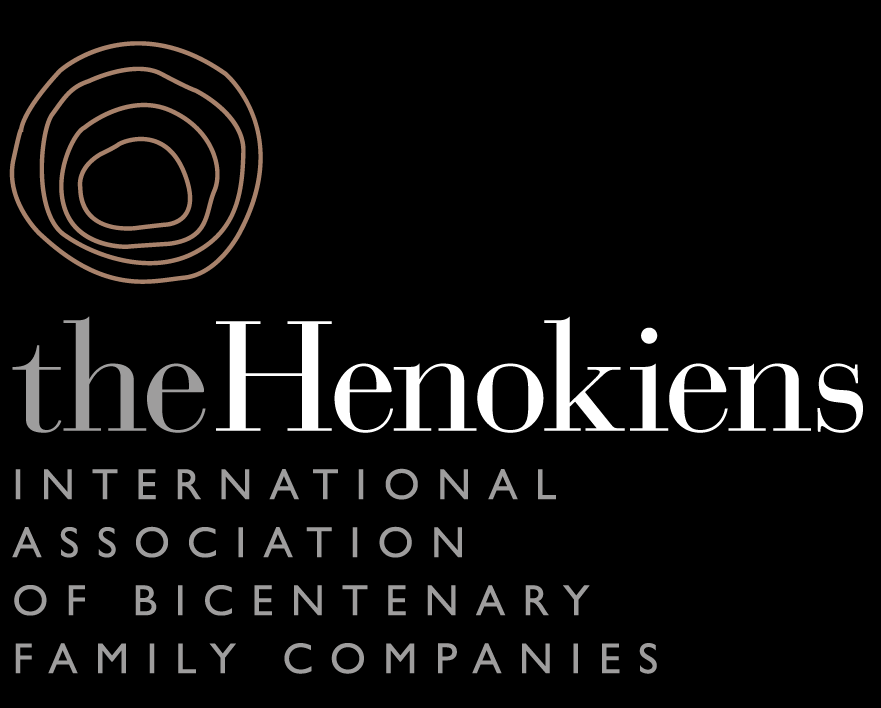Planning the Future
BECOMING AN HENOKIEN ONE DAY :
51 QUESTIONS TO PREPARE THE HANDING DOWN OF A FAMILY COMPANY : click here
The companies, members of the Henokiens Association, meet four criteria:
- they have reached a minimum age of 200 years,
- they are managed by a descendant of the founder,
- the family still owns the company or is the majority share holder,
- they are in good financial health.

Through this Association, they try to show the adaptability of some of the oldest and most experienced companies in the world, while proposing answers to the questions that numerous managers have raised on the initiatives that should be taken to maintain, to develop or to transmit their company to future generations, under the best possible conditions.
In fact, managing a company whose own family is the majority share holder is a very difficult job. So difficult that most of the managers do not think or do not have the time to organise the continuity of their company.
That is why, the Henokiens Association, has considered it a good idea to propose on its Web site the questionnaire drawn up by the university professor, William Tim O'Hara.
Designed in the framework of audit meetings held with American family firms, this 51-question questionnaire does not necessarily reflect the condition of each company and each family but it could be used as a tool for reflection to help determine if a company is properly planning for its future.
It must allow identifying the subjects on which a manager of a family company has to be perfectly prepared, those to which he will have to pay particular attention or those concerning which he will necessarily have to take initiatives.
The contents of this guide is proposed for general information purposes only. It is not designed to replace the services of professional advisers and should not be used for that purpose. You are urged to contact professional advisors concerning questions pertaining to your own specific situation.
William T.O'Hara is the founder and the Director of the Institute for Family Enterprise at Bryant College in Rhode Island (USA). He has spent a number of years involved in family business research which has given him the opportunity to meet the different members of the Henokiens Association. He is author of the book: "Centuries of Success: Lessons from the World's Most Enduring Family Businesses".
51-Points .Guideline
This guide is proposed for general information purposes only. It is not designed to replace the services of professional advisers. Should you need thorough guidance we advise you to consult professional assistance
1- Strategic planning :
- Family goals and expectations for the business have bean identified.
- There is a written long-range stratagic plan covering more than one year.
- The long term plan integrates the objectives of the business and personal goals of the family members.
- In addition to family objectives, the long term strategy also includes objectives for earnings, return on investment, capital growth, market share and sales/earnings ratios.
- Performance evaluations of family members are conducted on a regular basis to determine qualifications and professional development.
- The strategic plan supports the succession plan.
- The strategic plan supports the estate plan.
- Non-family managers are considered in the strategic plan.
- Family members not active in the business understand the role and responsibility of non-participating members.
- The family is in agreement upon the nature of the business.
- The family has an existing method or process to settle family disputes.
- The family meets regularly to discuss business issues.
- The family has an outside board of advisors.
- The family reviews and revises the strategic plan on a periodic basis.
2- Succession planning:
- The family has agreed that continuing ownership of the business is a goal.
- Family members have a positive image of the company and understand the benefits of being a family business.
- Everyone agrees that entry into the family business is completely voluntary.
- The family has determined who is eligible to become a successor.
- All prospective candidates have been objectively considered and evaluated.
- The career alternatives, personal interests and talents and family circumstances of each prospective candidate have been considered.
- Expectations regarding formal education requirements for successors have been determined and everyone understands what they are.
- Requirements for successors regarding length and duration of experience outside of the company and/or apprenticeships within the company also have been determined and stated.
- A succession transition period has been identified and agreed to by the family.
- The family has determined a schedule for delegating responsibility/tasks to the successor during the transition period.
- Specific responsibilities for guidance and supervision of the successor have been accepted.
- Non-family managers are included in the process of bringing on the successor.
- A means to evaluate a successor's performance is in place.
- Rules and conditions have been set for the successor's financial compensation, advancement and promotion within the company.
- A reliable information flow is in place to insure the retiring owner is aware of all major business decisions.
- A set of transition controls is in place to monitor the pace, quality and outcome of the transition process.
- The family and company have contingency plans if the successor leaves or must be replaced.
- The owner/founder has a meaningful and active retirement planned.
- The owner/founder determined when and how he wanted to leave.
3- Succession of the goods :
- The owner/founder has determined when and how to "let go."
- The owner/founder and his/her spouse have discussed the lifestyle they will lead after leaving the business.
- The owner/founder has calculated the income needed to support this lifestyle.
- The business is organized so that its tax burden is minimized to the greatest degree possible.
- The owner/founder has investigated the various methods to defer texable income into the future.
- The owner/founder has decided whether to transfer ownership of the business during his/her lifetime or through his/her estate.
- The owner/founder has decided who or which combination of individuals will receive the business and what the ownership structure will be.
- The owner/founder has considered what transfer method is best for his/her personal and business objectives.
- The owner/founder has investigated the various methods to transfer the business.
- Proper insurance coverage has been obtained.
- If the owner/founder will bequeath the business, she has included use of the annual gift tax exclusion and unified credit in the planning.
- The owner/founder has retained some sort of ownership leverage should the transfer not work out as anticipated.
- The business has been valued.
- If the value is based on a fixed dollar amount rather than a formula, the value is reviewed yearly to avoid inequities.
- All plans have been implemented through appropriate legal documents.
- Emergency plans have been devised should something unexpected happen to the owner/founder which leaves s/he unable to manage the business on a day-to-day basis.
- Estate planning is reviewed annually.
- The estate plan supports the succession and strategic plans.

